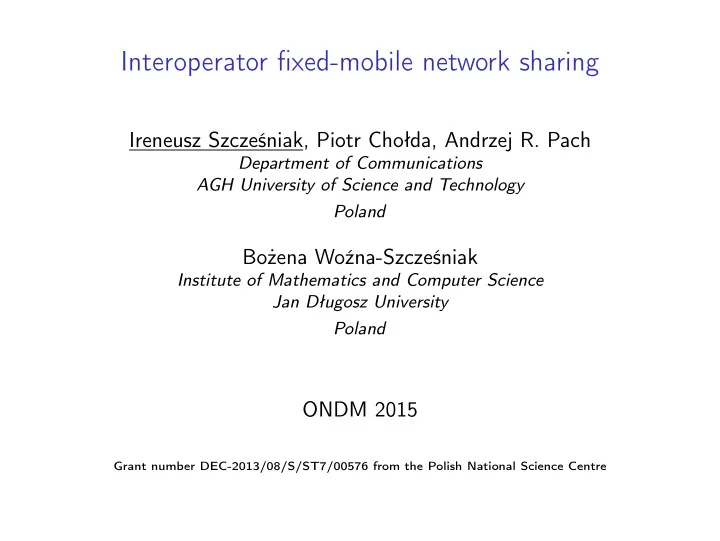

Interoperator fixed-mobile network sharing Ireneusz Szcześniak, Piotr Chołda, Andrzej R. Pach Department of Communications AGH University of Science and Technology Poland Bożena Woźna-Szcześniak Institute of Mathematics and Computer Science Jan Długosz University Poland ONDM 2015 Grant number DEC-2013/08/S/ST7/00576 from the Polish National Science Centre
Introduction Contribution Evaluation Results Conclusions Introduction • Fixed-mobile networks are wide-spread, and expensive. • Operators need to share, but sharing is limited. • Sharing of physical infrastructure: buildings, masts, etc. • Roaming and virtual operators are about leasing, not sharing. • Operators can build joinly a single network and use it together. • Sharing can improve performance and bring resiliency. • Performance improvement is so needed for 5G. • Currently, fixed-mobile networks are not resilient. slide 1
Introduction Contribution Evaluation Results Conclusions Novel idea The novel idea of interoperator fixed-mobile network sharing, and the evaluation of the benefits the sharing brings in terms of resiliency. The hallmark of our proposed sharing is the interoperator communication in access networks. slide 2
Introduction Contribution Evaluation Results Conclusions Interoperator fixed-mobile network sharing in general Internet IP network O1 O2 × default default × router router interoperator trunk aggregation Ethernet × × network switch access O1 O2 IC network FMN FMN slide 3
Introduction Contribution Evaluation Results Conclusions Interoperator sharing in passive optical networks IC IC CO CO IC slide 4
Introduction Contribution Evaluation Results Conclusions Disclaimer: we need active nodes • In the proposed sharing we need active remote nodes. • Active, not passive, nodes can diverge traffic to a backup path. • But it’s hard to argue for active nodes in passive optical networks... • So active nodes are also needed for: • longer reach, • better performance, • inter-ONU communication, • inter-base station communication, slide 5
Introduction Contribution Evaluation Results Conclusions Evaluation scenarios • How does the proposed sharing improve the service availability? • An ONU is capable of the interoperator communication or not. • We studied two scenarios: • in the first, the locations of active remote nodes are given, • in the second, the active nodes are randomly distributed. slide 6
Introduction Contribution Evaluation Results Conclusions First scenario, and second too 1 − s 1 − s CO s s 1:g 1:g 1:g 1 − s 1 − s 1 st stage 2 nd stage 3 rd stage slide 7
Introduction Contribution Evaluation Results Conclusions Service availability calculation • Numerical evaluation: a mix of analysis and Monte Carlo simulation. • We analytically evaluate a given, concrete network. • We randomly produce a sample of concrete networks from the populations with the given probabilities: • r - an ONU is capable of inter-operator communication, • q - a remote node is active. • We produced 87400 concrete networks, and averaged the results. slide 8
Introduction Contribution Evaluation Results Conclusions Service availability calculation - continued Calculations: traversing the reliability block diagram. The availability is calculated using this recursive function: 1 st case a c a u c → c f ( u c , c ) 2 nd case 0 3 rd case a c f ( c , p ) = 4 th case a c ( 1 − � ( 1 − a i → c f ( i , c ))) i ∈ N c i � = p 5 th case h c ( 1 − � ( 1 − d c , v )) v ∈ V c slide 9
Introduction Contribution Evaluation Results Conclusions Service availability calculation - an interesting case IC-ONU1 NIC-ONU IC-ONU2 slide 10
Introduction Contribution Evaluation Results Conclusions Results for the first scenario 1 st scenario 1 r = 0 traditional baseline availability 0.9995 0.999 10 − 3 10 − 2 10 − 1 10 0 r slide 11
Introduction Contribution Evaluation Results Conclusions Results for the second scenario 1 availability 0.9995 0.999 1 0 . 5 10 0 0 10 − 1 10 − 2 10 − 3 q r slide 12
Introduction Contribution Evaluation Results Conclusions Conclusions • We proposed the interoperator fixed-mobile network sharing. • We evaluated the benefits the sharing brings in terms of resiliency. • Downtime can be significantly reduced with little network upgrades. • Upgrades can be rolled out in stages and where needed most. • The proposed sharing should improve performance too. • There are many problems to solve, for instance: • performance studies, • optimization, • implementation details. slide 13
Recommend
More recommend